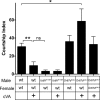Activation of the T1 neuronal circuit is necessary and sufficient to induce sexually dimorphic mating behavior in Drosophila melanogaster
- PMID: 20164344
- PMCID: PMC3426441
- DOI: 10.1523/JNEUROSCI.4819-09.2010
Activation of the T1 neuronal circuit is necessary and sufficient to induce sexually dimorphic mating behavior in Drosophila melanogaster
Abstract
The molecular and cellular events mediating complex behaviors in animals are largely unknown. Elucidating the circuits underlying behaviors in simple model systems may shed light on how these circuits function. In drosophila, courtship behavior provides a tractable model for studying the underlying basis of innate behavior. The male-specific pheromone 11-cis-vaccenyl acetate (cVA) modulates courtship behavior and is detected by T1 neurons, located on the antenna of male and female flies. The T1 neurons express the odorant receptor Or67d and are exquisitely tuned to cVA pheromone. However, cVA-induced changes in mating behavior have also been reported upon manipulation of olfactory neurons expressing odorant receptor Or65a. These findings raise the issue of whether multiple olfactory-driven circuits underlie cVA-induced behavioral responses and what role these circuits play in behavior. Here, we engineered flies in which the Or67d circuit is specifically activated in the absence of cVA to determine the role of this circuit in behavior. We created transgenic flies that express a dominant-active, pheromone-independent variant of the extracellular pheromone receptor, LUSH. We found that, similar to the behaviors elicited by cVA, engineered male flies have dramatically reduced courtship, whereas engineered females showed enhanced courtship. cVA exposure did not enhance the dominant LUSH-triggered effects on behavior in the engineered flies. Finally, we show the effects of both cVA and dominant LUSH on courtship are reversed by genetically removing Or67d. These findings demonstrate that the T1/Or67d circuit is necessary and sufficient to mediate sexually dimorphic courtship behaviors.
Figures



Similar articles
-
The Drosophila pheromone cVA activates a sexually dimorphic neural circuit.Nature. 2008 Mar 27;452(7186):473-7. doi: 10.1038/nature06808. Epub 2008 Feb 27. Nature. 2008. PMID: 18305480
-
Love makes smell blind: mating suppresses pheromone attraction in Drosophila females via Or65a olfactory neurons.Sci Rep. 2014 Nov 19;4:7119. doi: 10.1038/srep07119. Sci Rep. 2014. PMID: 25406576 Free PMC article.
-
Ligands for pheromone-sensing neurons are not conformationally activated odorant binding proteins.PLoS Biol. 2013;11(4):e1001546. doi: 10.1371/journal.pbio.1001546. Epub 2013 Apr 30. PLoS Biol. 2013. PMID: 23637570 Free PMC article.
-
Odor and pheromone detection in Drosophila melanogaster.Pflugers Arch. 2007 Aug;454(5):749-58. doi: 10.1007/s00424-006-0190-2. Epub 2007 Jan 5. Pflugers Arch. 2007. PMID: 17205355 Review.
-
Pleiotropic actions of the male pheromone cis-vaccenyl acetate in Drosophila melanogaster.J Comp Physiol A Neuroethol Sens Neural Behav Physiol. 2015 Sep;201(9):927-32. doi: 10.1007/s00359-015-1020-9. Epub 2015 Jun 24. J Comp Physiol A Neuroethol Sens Neural Behav Physiol. 2015. PMID: 26105507 Free PMC article. Review.
Cited by
-
Volatile Drosophila cuticular pheromones are affected by social but not sexual experience.PLoS One. 2012;7(7):e40396. doi: 10.1371/journal.pone.0040396. Epub 2012 Jul 11. PLoS One. 2012. PMID: 22808151 Free PMC article.
-
Drosophila pheromone-sensing neurons expressing the ppk25 ion channel subunit stimulate male courtship and female receptivity.PLoS Genet. 2014 Mar 27;10(3):e1004238. doi: 10.1371/journal.pgen.1004238. eCollection 2014 Mar. PLoS Genet. 2014. PMID: 24675786 Free PMC article.
-
A Drosophila DEG/ENaC subunit functions specifically in gustatory neurons required for male courtship behavior.J Neurosci. 2012 Mar 28;32(13):4665-74. doi: 10.1523/JNEUROSCI.6178-11.2012. J Neurosci. 2012. PMID: 22457513 Free PMC article.
-
Evolution of Reproductive Behavior.Genetics. 2020 Jan;214(1):49-73. doi: 10.1534/genetics.119.302263. Genetics. 2020. PMID: 31907301 Free PMC article. Review.
-
The PLOS Biology XV Collection: 15 Years of Exceptional Science Highlighted across 12 Months.PLoS Biol. 2019 Feb 27;17(2):e3000180. doi: 10.1371/journal.pbio.3000180. eCollection 2019 Feb. PLoS Biol. 2019. PMID: 30811478 Free PMC article. No abstract available.
References
-
- Amrein H. Pheromone perception and behavior in Drosophila. Curr Opin Neurobiol. 2004;14:435–442. - PubMed
-
- Benton R, Vannice KS, Vosshall LB. An essential role for a CD36-related receptor in pheromone detection in Drosophila. Nature. 2007;450:289–293. - PubMed
-
- Clyne P, Grant A, O'Connell R, Carlson JR. Odorant response of individual sensilla on the Drosophila antenna. Invert Neurosci. 1997;3:127–135. - PubMed
-
- Couto A, Alenius M, Dickson BJ. Molecular, anatomical, and functional organization of the Drosophila olfactory system. Curr Biol. 2005;15:1535–1547. - PubMed
-
- Datta SR, Vasconcelos ML, Ruta V, Luo S, Wong A, Demir E, Flores J, Balonze K, Dickson BJ, Axel R. The Drosophila pheromone cVA activates a sexually dimorphic neural circuit. Nature. 2008;452:473–477. - PubMed
Publication types
MeSH terms
Substances
Grants and funding
LinkOut - more resources
Full Text Sources
Molecular Biology Databases
